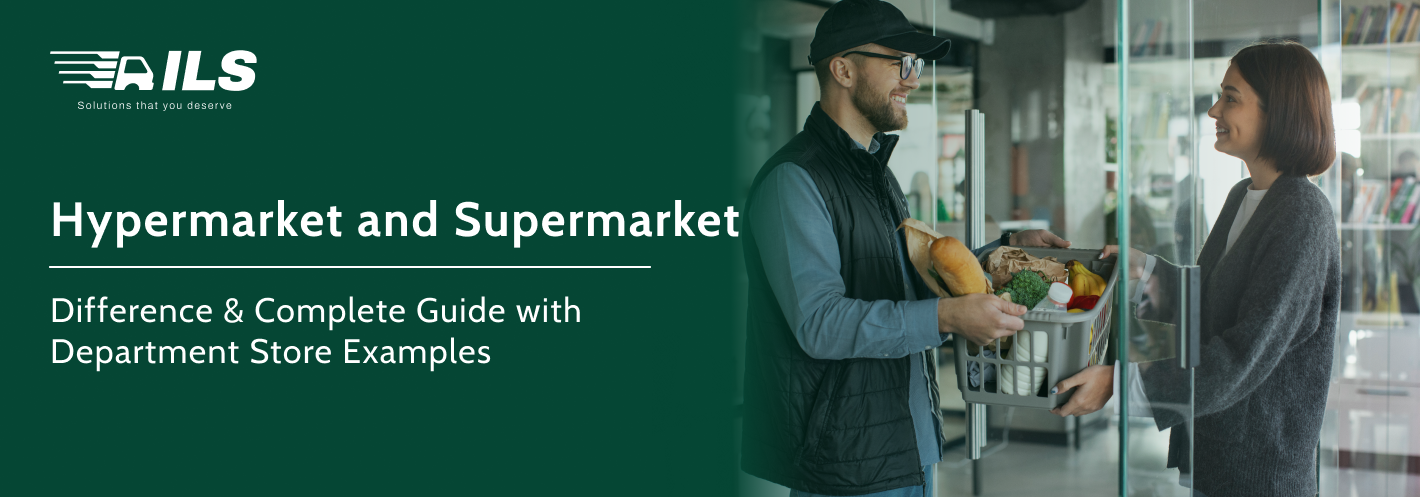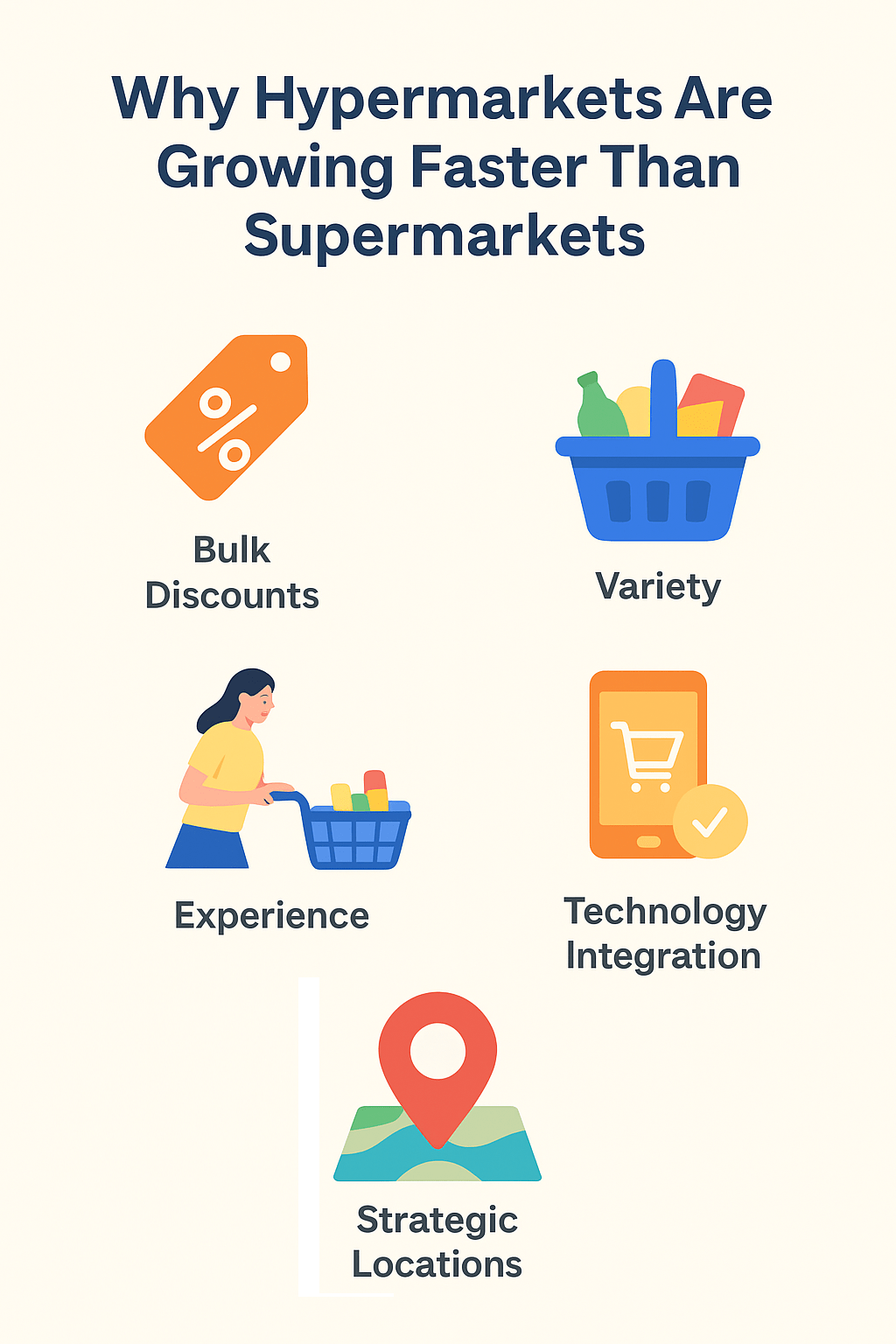Hypermarket and Supermarket Difference: Complete Guide with Department Store Examples
Ecommerce Tips & Tutorials
Understanding the difference between a supermarket and a hypermarket is essential for both consumers and retailers. While both aim to offer a variety of products conveniently, their scale, range, and shopping experience differ greatly. In this comprehensive guide, we'll explore what a department store is, the differences between a supermarket and a hypermarket, provide examples of department stores, and explain how platforms like the ILS Portal can simplify retail logistics and management.
Understanding Supermarkets, Hypermarkets, and Department Stores
Supermarkets, hypermarkets, and department stores may seem similar, but each serves a unique purpose in retail. This section helps you understand how they differ in size, product range, and shopping experience, so you can easily identify which best suits your needs.
What Is a Supermarket?
A supermarket is a large self-service retail store primarily focused on selling food, groceries, and everyday household essentials. Supermarkets are designed to offer convenience to customers living in urban and suburban areas by providing a wide selection of products in one place.
Key Features of a Supermarket:
- Focuses mainly on groceries and household products.
- Typically located in residential or nearby urban areas.
- Offers branded and local products at competitive prices.
- Organised into clear categories such as dairy, frozen foods, beverages, etc.
- Emphasises convenience and fast shopping.
Example:
Famous supermarket examples include Big Bazaar, Reliance Smart, and Spencer's Daily. These stores focus on quick, everyday shopping for customers within city limits.
Supermarkets are ideal for customers who prefer short, convenient shopping trips rather than spending hours in a large store.
What Is a Hypermarket?
A hypermarket is a combination of a supermarket and a department store. It's much larger in size and offers an extensive range of products, including groceries, electronics, clothing, furniture, and household appliances, all under one roof.
The main difference between supermarket and hypermarket lies in their size and the product variety they offer. A hypermarket aims to provide a one-stop shopping experience where customers can purchase almost everything they need at lower prices, thanks to the bulk purchasing power.
Key Features of a Hypermarket:
- Combines the features of both supermarket and department store.
- Offers groceries, electronics, apparel, and even home furnishings.
- Occupies larger spaces (usually 80,000–250,000 sq. ft).
- Located in the city outskirts or large commercial zones.
- Provides bulk discounts and competitive pricing.
Example:
Some well-known hypermarket examples include Walmart, Carrefour, Big Bazaar HyperCity, and Tesco Extra. These stores serve as shopping destinations where families can buy everything in one trip.
What Is a Department Store?
Before we go deeper into the hypermarket and supermarket difference, it's important to understand what is a department store.
A department store is a large retail establishment divided into departments, each specialising in a specific product category. Unlike supermarkets (which mainly sell food and groceries), department stores focus on lifestyle products, such as fashion, electronics, home décor, and beauty items.
Department Store Examples:
- Shoppers Stop – Focuses on fashion, accessories, and home goods.
- Lifestyle – Offers clothing, footwear, and home décor.
- Macy's – A global retail giant known for premium fashion and home products.
Department stores are often located in malls or commercial centers, designed to offer a premium and organised shopping experience.
Also Read: https://ilsportal.io/blogs/how-to-write-address-on-envelope
Key Differences Between Supermarket and Hypermarket
| Feature | Supermarket | Hypermarket |
|---|---|---|
| Primary Focus | Groceries & household items | Groceries + electronics, clothing, appliances |
| Store Size | Medium (10,000–40,000 sq. ft) | Very large (80,000–250,000 sq. ft) |
| Location | Within city or residential areas | City outskirts or malls |
| Pricing Strategy | Competitive, focused on convenience | Discounted bulk pricing |
| Product Range | Limited categories | Extensive multi-category range |
| Customer Experience | Quick and convenient shopping | One-stop family shopping |
Difference Between Supermarket and Hypermarket Explained
The difference between supermarket and hypermarket primarily comes down to scale, range, and shopping purpose.
A supermarket serves customers looking for daily essentials, such as fruits, vegetables, dairy, snacks, and cleaning products, in a convenient and accessible location.
A hypermarket, on the other hand, caters to larger, less frequent shopping trips. It combines the functions of a supermarket and department store, providing groceries along with fashion, electronics, and home appliances.
In Short:
- A supermarket = Groceries and daily essentials.
- A hypermarket = Supermarket + Department store under one roof.
Hypermarkets also enjoy bulk buying power, allowing them to offer lower prices, while supermarkets focus on convenience and accessibility.
Also Read: https://ilsportal.io/blogs/pod-proof-of-delivery
Why Hypermarkets Are Growing Faster Than Supermarkets
The retail landscape is evolving, and hypermarkets are gaining popularity due to changing consumer habits. With increasing demand for one-stop shopping, more consumers prefer buying groceries, fashion, and home goods in a single trip.

Reasons Behind the Growth:
- Bulk Discounts: Lower prices attract families and bulk buyers.
- Variety: Greater product assortment than a typical supermarket.
- Experience: Spacious layout and parking convenience.
- Technology Integration: Self-checkout and digital payment options.
- Strategic Locations: Near highways or major commercial zones for easy access.
Supermarkets continue to thrive in cities where space constraints and convenience matter most, while hypermarkets dominate suburban and rural markets.
The Role of ILS Portal in Modern Retail and Logistics
Managing inventory and logistics efficiently is a crucial challenge for both supermarkets and hypermarkets. This is where the ILS Portal (Indian Logistics Services) comes in.
ILS Portal helps retailers, distributors, and logistics providers streamline shipping, tracking, and delivery processes with automation and integration across courier partners. Whether you're managing a supermarket chain or a hypermarket warehouse, ILS ensures smooth logistics, real-time tracking, and faster fulfillment.
With the ILS Portal, managing large-scale retail logistics becomes more efficient, transparent, and cost-effective. Read about the warehouse management.
Department Store vs Supermarket vs Hypermarket: Which One Suits You?
Your choice depends on your shopping goals.
- If you prefer convenience and quick shopping trips, go for a supermarket.
- If you want to buy in bulk and enjoy discounts, choose a hypermarket.
- If you want quality and variety in lifestyle goods, visit a department store.
Each format serves a different customer need, from daily grocery shopping to lifestyle upgrades.
Examples of Popular Stores Worldwide
| Category | Examples |
|---|---|
| Supermarket | Reliance Smart, More Retail, Aldi, Kroger |
| Hypermarket | Walmart, Carrefour, Tesco, Big Bazaar HyperCity |
| Department Store | Shoppers Stop, Lifestyle, Macy’s, Kohl’s |
These examples show how each retail format caters to different markets, customer needs, and price segments.
Why Understanding the Difference Matters
For consumers, understanding the difference between hypermarket and supermarket helps make better purchasing decisions. For businesses, it's about choosing the right retail model based on target customers, store location, and supply chain efficiency.
Retailers planning to expand can utilise platforms like the ILS Portal to manage their logistics network, ensuring timely deliveries and enhanced operational control. Read about the functions of retailing.
Conclusion
The difference between supermarket and hypermarket comes down to size, variety, and shopping experience. While supermarkets emphasize convenience and accessibility, hypermarkets combine the strengths of both supermarkets and department stores to create an all-in-one shopping destination.
Understanding what is a department store and exploring department store examples also helps identify how retail formats serve different customer needs.
Whether you're a shopper or a retailer, knowing these differences and using modern solutions like the ILS Portal ensures smarter, more efficient retail decisions in today's competitive market.
Frequently Asked Questions
1. What is the main difference between a supermarket and a hypermarket?
A supermarket focuses mainly on groceries and daily essentials. At the same time, a hypermarket combines the features of a supermarket and a department store, offering a wide range of products, from groceries to electronics and clothing.
2. What is a department store?
A department store is a large retail store divided into sections (departments), each specialising in a particular product category like clothing, furniture, or beauty products.
3. What are some department store examples?
Examples include Shoppers Stop, Lifestyle, and Macy's, which focus on lifestyle, fashion, and home products.
4. Is a hypermarket bigger than a supermarket?
Yes. Hypermarkets are much larger, often combining the variety of a supermarket and department store, making them ideal for one-stop shopping.
5. Why are hypermarkets cheaper than supermarkets?
Hypermarkets buy in bulk and sell high volumes, allowing them to offer lower prices compared to supermarkets that operate in smaller spaces.

